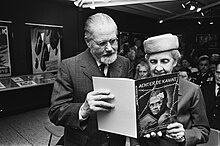You can help expand this article with text translated from the corresponding article in Dutch. Click [show] for important translation instructions.
|
Charles Burki (1909–1994) was a Dutch illustrator and motorcycle enthusiast, born and raised in colonial Indonesia (the Dutch East Indies) and educated at the Ecole des Beaux-Arts, Paris. He worked extensively for DAF trucks, Shell, Philips, KLM, Goodyear, and for such magazines as Motor, Moto Revue, Sport in Beeld.[1]

During WWII, Burki was interned in a Japanese POW camp and managed to record the experience. The drawings were subsequently published in his book Behind Barbed Wire (Dutch: Achter de Kawat).[2] Burki returned to the Netherlands in 1945 and lived in the Hague until his death in 1994. His work has been commemorated in exhibitions,[3] postcards,[4] and postal stamps.[5]
References
edit- ^ d'Orléans, Paul (May 4, 2020). "Charles Burki: Streamliners". The Vintagent.
- ^ Burki, Charles (1979). Achter de kawat : als Japans krijgsgevangene. Amsterdam: Buijten & Schipperheijn. ISBN 9061352959.
- ^ "CHARLES BURKI (1909-1994)". Kunsthal Rotterdam. Retrieved 28 September 2023.
- ^ "Search results for: 'Charles Burki (1909-1994)'". www.artunlimitedshop.co.uk.
- ^ "Stamp 2010, Netherlands - Personal stamps TNT/PNL Charles Burki 3 booklets, 2010". PostBeeld stamp shop Haarlem.
Further reading
edit- Krell, A. (2002). The devil's rope: a cultural history of barbed wire. London: Reaktion Books. pp. 94-100.
- Denters, V. (1997). Charles Burki: de kunst van het motorrijden. Bussum: Thoth.
This article needs additional or more specific categories. (September 2023) |